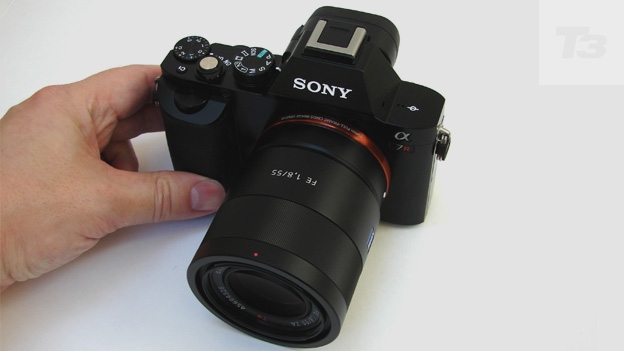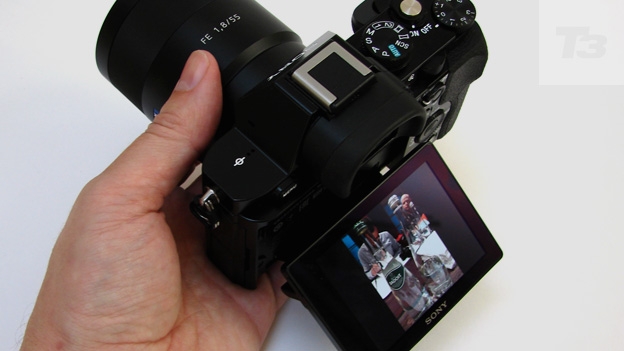Sony A7R review
The Sony A7R is the first full-frame mirrorless compact system camera


-
+
Pro-grade sensor
-
+
Tilting LCD
-
+
Rock solid build quality
-
-
Price
-
-
Battery life could be better
Why you can trust T3






Along with the Sony A7, this is the brand's latest compact system camera, promising pro resuilts from a portable body. Here's our Sony A7R review
When the Sony A3000 DSLR was introduced late last year, it was the first Alpha model to feature the smaller E-mount that up until then had only been seen on its NEX compact system cameras (CSCs). At the time we wondered whether this meant the end of the A-mount, as up until that point, all Sony DSLRs had featured A-mount lenses.
On the contrary, it transpired, this was instead an early sign of the phasing out of Sony's NEX branding; from now on, all of its interchangeable lens cameras - both CSC and DSLR - will carry the Alpha logo.
Following on from this decision, we now have the first Alpha branded CSC in the Sony A7, a 24.3 megapixel model, and its outwardly identical Sony A7R brother, the 36.4-megapixel mini-DSLR styled unit we're testing here.
Now that's cleared up, what's the A7R offering that its forbears didn't? Well, along with the A7, the A7R is Sony's first - and indeed the world's first - E-mount compact system camera to feature a full-frame sensor.
By that we mean an imaging chip the exact same size as a frame of old 35mm film. Previously only professional digital SLRs priced at £2K and upwards would offer such a physically large sensor - and the cameras themselves would traditionally be bigger and bulkier than the A7R, even though this camera is clearly inspired by a DSLR's design.
As a bigger performance from a smaller camera is for some photography's Holy Grail, unsurprisingly the A7R CSC isn't cheap. The asking price is currently £1,700 body only, while the lower resolution A7 comes in at £1,300 without any lens.
Pixel count aside, another key difference, which the R in the name makes it easy to remember, is that the A7R has had its optical low-pass filter removed to eek out just a smidgeon more detail.
This removal of a filter that at one time was placed there to help avoid image artefacts - such as densely packed lines on a shirt seeming to vibrate before the eyes (moiré) - is a trend amongst high-end cameras such as the Nikon D7100, Sony Cyber-Shot RX1R and the Nikon Df.
To deliver what its maker claims is a high-speed auto focus response, this latest Sony also comes with a brand new Bionz processor, said to be 35% faster than that of the previously range-topping Sony NEX-7.
Like that model, the A7R comes with an eye level viewfinder in addition here to the obvious advantage of a tilting backplate LCD, so in terms of composition it very much has all bases covered.
But it's not just about size of sensor or indeed feature set. To get optimum results, a full-frame sensor needs to be matched with a decent piece of glass, of course.
Sony supplied our A7R review sample with a 55mm Carl Zeiss E-mount 'prime' (fixed focal length) lens offering a maximum aperture of a bright f/1.8 and a manual focus ring for the kind of precise hands-on adjustment that anyone spending this amount of dosh will surely want. So let's see how the camera and lens combination performs as we put it through its paces.
Sony A7R: Controls
While a pair of top plate dials to control exposure and shooting modes, as well as a vacant hotshoe for flash, marks this out as a camera for those who like to get hands on with their photography, Sony has'ít overdone the controls or tried to cram too much in.
Generally buttons and dials are well placed within reach of forefinger and thumb, though the camera did feel weightier in the hands than we expected it to with lens attached - not always a bad thing when you're investing this amount of money and are looking for a digital workhorse. Small yet tough is how Sony itself describes the A7R.
Sitting between the two aforementioned dials on the camera's top plate is a raised shutter release button encircled by an on/off switch, as we might expect to find on the DSLR the A7R resembles.
Give this a flick and within a couple of seconds the A7R is ready for a squeeze of the trigger. Not as lightning fast as some DSLRs and CSCs to power up from cold then, but auto focus is where it steps up to its mark, appearing swifter to determine that sweet spot in terms of focus and exposure than we were able to blink.
If busier scenes do have the camera's AF occasionally confused, naturally at this level there is the ability to focus manually too, which in fairness is the setting that most of its semi-pro/pro target audience will naturally opt for anyway.
While at the back of the camera there is a scroll wheel and command dial for racing through menu settings, we could have done with a dedicated back button to retrace our steps - the scroll wheel being so responsive that it's easy to over shoot settings you actually wanted before you've fully got the measure of the camera.
The LCD screen here isn't a touch screen in this instance, so we're reliant on the physical controls instead. Thankfully then, in sitting somewhere between a premium-end fixed lens compact and a consumer DSLR, there's nothing that feels over engineered or extraneous about the A7R or its control layout.
Sony A7R: Screen
As we noted in our intro, the A7R takes a best of both worlds approach in offering photographers and videographers both an eye level electronic viewfinder (EVF), larger than many on compacts at 0.5-inches - activated with the aid of built-in eye sensor - plus a larger, tilting 3-inch LCD screen just below.
This can be angled up or down as the user sees fit, to enable those handheld shots low to the ground or held high at arm's length. Like previous Sony CSCs, it cannot be flipped out parallel to the body or indeed here angled to face the subject for a selfie. But then arguably the narcissistic self-portrait brigade isn't exactly who this £1,700 camera is targeting.
In combination, with the option of the EVF or bigger LCD with which to compose and review shots we have a best of both worlds approach that satiates traditionalists whilst providing, via the angle adjustable LCD, a greater variety of compositional choices.
Screen resolution incidentally is a semi-pro 921,600 dots, while the smaller EVF is sharp enough to be able to focus manually and determine by eye alone whether you've hit that sweet spot in terms of sharpness.
Sony A7R: Battery
As expected, the Sony A7R comes with a rechargeable lithium ion battery - a chunky NP-FW50 cell that slots into the base of its handgrip, as such a battery would for a DSLR.
As the camera closely resembles a DSLR in miniature we were expecting a battery life to compete with such models found in its price bracket, but in fact the A7R more closely matches a compact system camera performance of 270 shots from a full charge.
So, this is one performance aspect of the A7R that professionals will demand could be better. As seems to be the case with Sony models these days, such as the Sony RX10 released at the same time as this camera, the battery is charged within the body via adapter lead supplied, rather than being given its own standalone charger.
Get all the latest news, reviews, deals and buying guides on gorgeous tech, home and active products from the T3 experts
Sony A7R: Picture quality
As well as photo enthusiasts, there will be many professionals interested in this camera as either a backup to their full-frame digital SLR, such as the Sony A99, or on many occasions a straight replacement for it.
Despite the smaller overall form factor, as with the likes of other higher end CSCs such as the Olympus OM-D, it outwardly resembles a DSLR significantly enough to appear professional.
So does it cut the mustard? Twinned with a pro-grade prime lens - which traditionally offers a better consistency and sharpness of image than a zoom lens - the answer would have to be yes.
A lens aperture of f/1.8 in combination with the body feeling weighty in the palm enabled us to shoot hand held under artificial light at ISO1600 and avoid blur, while at the same time providing an attractively shallow depth of field (and a noise-free one at that) that allowed us to separate subjects from potentially distracting backgrounds.
The result was an image that looked professional - ie a match for the kind of shot we're more used to being seen delivered by a DSLR - plus, thanks to all those pixels, we were getting sufficiently large file sizes to be considered professional, too.
Colour appears spot on, while detail is so razor sharp that every variation in skin tone or facial blemish is picked up. So if you haven't shaved or have had a few late nights beware.
As this camera is all about the quality of the stills it produces, in some ways it feels like the inclusion of video here is very much secondary - especially as the dedicated record button seems placed a little out of the way on the edge of the handgrip instead of being located directly beneath the thumb.
However the movie recording specs asre once again top notch, in offering the Full HD 1920x1080 pixels at a maximum frame rate of 60fps, with stereo microphones positioned either side of the viewfinder housing.
Sony A7R: Verdict
So in the large sensor incorporating Sony A7R are we finally getting that dream mix of pro results from a portable camera body that compact system cameras have been working their way toward since their 2009 debut?
In truth, it's difficult to imagine results being much better. We get the high resolution that pros working commercially will want in 36.4 megapixels, arranged on the large 35mm film frame equivalent imaging sensor that matches professional DSLRs for size.
OK, so the E-mount here may be set up for a physically smaller lens than such cameras, but if you buy an adapter it's possible to still fit physically bigger A-mount lenses if you insist.
The conclusion is that, while it won't be justifiable for everyone, in the A7R Sony has pretty much produced the ultimate compact system camera as far as today's market is concerned. The exciting bit will be seeing where we go from here...
Sony A7R release date: Out now
Sony A7R price: £1,700 (body only)

Gavin Stoker has been writing about photography and technology for the past 20 years. He currently edits the trade magazine British Photographic Industry News - BPI News for short - which is a member of TIPA, the international Technical Imaging Press Association.